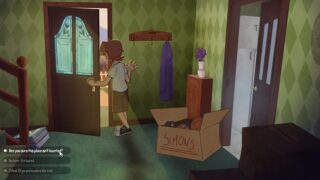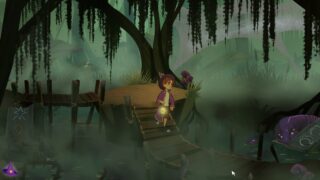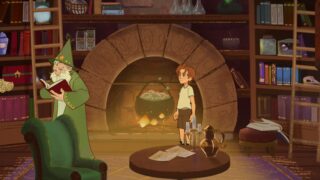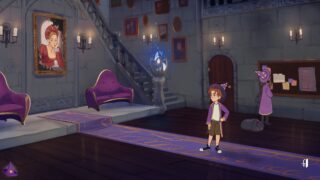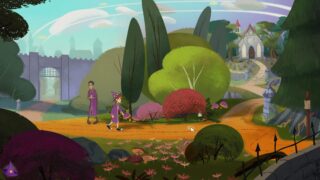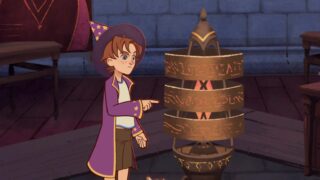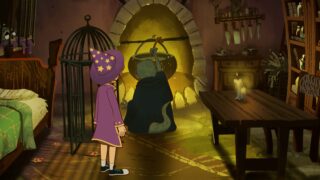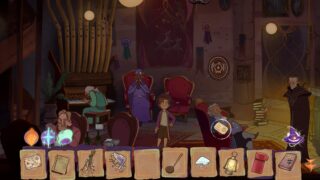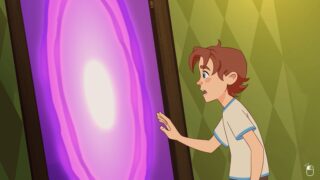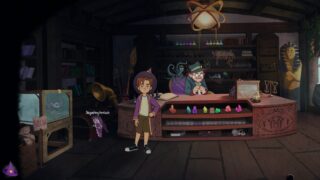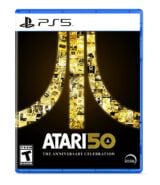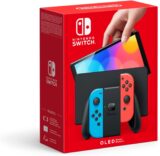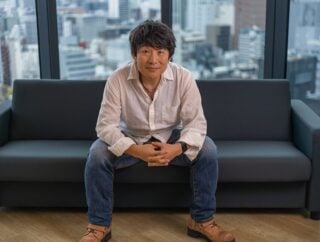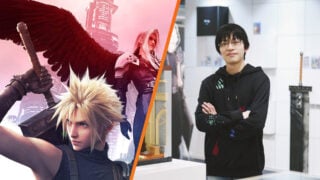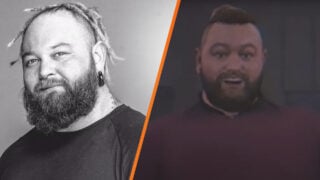How an Italian studio is bringing ’90s UK point-and-click Simon the Sorcerer to a new generation
Simon the Sorcerer Origins is coming in October, with Chris Barrie returning to voice the hero

For British players of a certain vintage, the name Simon the Sorcerer is enough to conjure (fittingly) some wonderful memories.
Although LucasArts is the developer most people think of when talking about early ’90s point-and-click adventures, there are plenty of other excellent examples of the genre that weren’t made by the Monkey Island studio, and Simon the Sorcerer was one of the most well-loved.
Created by UK studio Adventure Soft, Simon the Sorcerer was originally released on the Amiga and PC back in 1993. A CD version with voice acting was released the following year, with Chris Barrie (aka Rimmer from Red Dwarf) providing the voice of Simon himself.
A number of sequels followed, but for fans of the original (myself included), that original adventure is still the best of the bunch, despite now being around 33 years old.
On October 28 the series returns with Simon the Sorcerer Origins, an all-new adventure coming to PC and consoles, designed to tell the story of what happened right before the events of the first game.
Although it’s being handled by Italian developer Smallthing Studios, Origins was made with the blessing and advice of Adventure Soft, so hopes are high that it will live up to the brilliantly British humour of the original. What’s more, Chris Barrie is returning after more than three decades to voice Simon again.
To get more of a feel of how Simon the Sorcerer Origins came to be, VGC spoke to numerous members of the game’s development team, who promptly pulled answers out of their bottomless wizard hats.
Missy Calamai – Game director, designer, founder of Smallthing Studios
Although the first game is by far the most well-known, there were a whole bunch of Simon the Sorcerer games released over the years. While there will no doubt be a small group of hardcore Simon fans who love all the games, is Origins a bit like the Jurassic World of the series, in that its story is linked to the original and mainly ignores the sequels?
Origins is essentially a rebirth of the saga and is effectively a prequel to the first episode. The events take place a few weeks before Simon The Sorcerer 1 (1993), so the other episodes are not considered as the events have yet to happen.
Origins is a first-person title that doesn’t require prior knowledge of the saga – it’s a fresh start, but if a fan has played the first episode, they’ll find references and connections that will thrill them.
The original game obviously has a very British sense of humour. Given that Smallthing is based mainly in Italy, was it difficult to nail that tone and ensure that fans of the original would feel at home playing Origins?
It wasn’t difficult because I love – we love – the first episode of the saga, and we studied it in depth, evolving it, knowing that today’s technologies and the hand-drawn and animated techniques we wanted to use would allow us to refine the British comedy that defines the first episode.
It was wonderful to see Chris Barrie return and play the character, even giving us some advice during the live dubbing phase, so we could ensure the jokes and tone were perfectly captured.
The external testers, during the observation and final review phase, laughed so hard while playing at the jokes, the breaking of the fourth wall, and the gags. This truly filled us with emotion.
Speaking of the fans, how do you balance honouring the original game to keep them satisfied, while still introducing new elements to introduce the game to a new audience? Does making the game a prequel do that automatically because it doesn’t require previous knowledge of the story?
For us, it was essential to honour the saga and the first episode, to match them. This was an extremely complex task; it’s no coincidence that Origins required almost five years of work by a skilled staff.
We had to revamp the graphics to please fans and new players, and that’s why we aimed for a very intricate style, creating everything by hand as if it were a 1990s-2000s-style animated film. This way, we could offer acting and expressions, while maintaining a connection to the past that would appeal to many.
With the story, it was easier initially. We had something really good in store that the Woodroffes (the original authors) really liked, and when they were able to play it years later, they were thrilled, so much so that they said that, along with the first, it’s the best Simon ever written.
The story, as I was saying, is complete – you don’t need to know the saga or even the first episode. But if you’re a fan, as I said before, it will be a continuous thrill, from start to finish, right down to the last second, with quotes, connections, and answers. But what we’re proud of is that even if you don’t know the saga, you can simply experience a comical and emotional story.
Finally, we’ve done a huge amount of work on the gameplay, making the game available for every platform with any type of control – mouse and keyboard, pad with direct control, and even a curious mode where the pad controls a pointer. This also includes access to a number of options that allow for complete reconfiguration, even making the game quite retro.
It was a very long and demanding job – it made us sweat, having to ensure that all these conditions worked while enchanting fans and modern gamers. It was hard work, but it was worth it.

The point-and-click genre has seen something of a resurrection in recent years, but the modern video game landscape is still different to an extent. In this new era of accessibility, are you adding features to make sure players who need help can get it, while still ensuring it doesn’t make things too easy for the old-school players who like getting stuck and wandering around lost until they figure out the solution?
We wanted a challenging title, which in my opinion not only made it more fun, but also enhanced the story’s value, which revolves around Simon’s revenge.
In the first part of the game, we’ll have a tutorial, which is very fun and not overly simple, then we enter the real gameplay, which gradually becomes more open and complex. It requires ingenuity but is logical, obviously always in Simon’s somewhat botched way of doing things.
In terms of interface, we have the ability to view hotspots on screen, and Simon also keeps a diary of objectives to achieve, written somewhat in his own way. Nothing else. We believe we’ve distributed the right crumbs to find the way home.
How involved were the original Adventure Soft team in the game’s development? Were they mainly involved in the early stages then let you get on with it yourselves, or were they along for the full ride?
Initially (around 2020-21) they carefully checked the first steps, as much as they were in love with the style and the story that was taking shape. In the subsequent phases, until the development reached its peak, the checks decreased, and this was also my choice.
I wanted Simon and Mike Woodroffe to be as candid and objective as possible in evaluating the game during the beta phase – I was certain we were doing a truly good job. When we entered beta testing, their checks increased, and they checked all the text and dialogue in the game, approving it. How thrilling! We were truly happy with their reactions. Simon Woodroffe loved the style so much that he wanted to tattoo it on his body – the events and the story truly moved him.
How easy was it to get Chris Barrie to agree to return to play Simon?
I wish it had been. We really wanted him – if he hadn’t been [available], we would have lost part of the magic of his return. I’m not kidding when I say that searching for him and convincing him took a very long time, about 6 or 7 months.
He’s a famous actor and has a lot of commitments – managing to coordinate the dubbing work for a character who speaks for many hours isn’t easy, but in the end we did it, and his performance and kindness were fantastic! A true professional.
At the end of the live dubbing session, secretly, one by one, our entire creative team of designers and graphic designers showed up and applauded him. Chris Barrie wasn’t expecting it – he was moved to return to a character he played at the beginning of his career. We had almost finished everything after almost 5 years of work, and we were thrilled.

Guilia Valentini – Art Director
The story trailer makes a fun joke about how Simon used to look, with an 18-pixel-tall head (of which 10 pixels were his hat).
Did working with such low-res source material give you a feeling of freedom when working on Simon’s new design, or does it actually make things trickier because every fan will have ‘filled in the blanks’ and created their own vision of Simon in their head?
Aha, well, the hat is the most important part of a wizard’s presentation, it deserved all those glorious 10 pixels!
Speaking of the design though, we had the freedom, yes, but we did our best to find and preserve as many features as possible from the original character – finding the one frame in Simon the Sorcerer (1993) in which it’s made clear Simon has blue eyes was a revelation, I’ll tell you.
The implication of detail of the original pixel art gave us little to work with in terms of features, but a lot in vibes – especially with secondary characters like Calypso and Sordid – and I think we managed to nail them pretty well even with all the changes.
I won’t lie, it was no easy decision to be so daring with the redesigns (the hat! the entirety of Sordid!), and we knew the difference would be jarring for many, but in the end we didn’t want to let technical limitations from thirty years ago limit our creativity and vision.
Ultimately, we do not aim to replace the memory the fans have of the original games and their art style, simply to build upon that original foundation and share our own spin on it. And genuinely, I think players will like it!
The art style appears to be inspired by 90s and 2000s Disney animation. Can you tell us a bit more about the character design and animation process?
It very well was! We wanted to give the warm, nostalgic feeling of sitting in front of your tv watching cartoons after school, and no option fit better.
This also meant animating frame by frame, the traditional way, one drawing after the other. Nothing more, nothing less. We had to keep the designs quite simple for this to work in a realistic amount of time and effort though, and that’s why Simon doesn’t have stars all over his cape…

Mason Fisher – Composer
Because the game’s art style is reminiscent of 90s and early 2000s Disney cartoons, were you briefed to create a soundtrack that fits this tone, or were you given more freedom to create something that you thought best fit the game?
When composing the music score, Smallthing Studios and I thought it would be very important to keep the score nostalgic and reference the original game soundtrack. We also wanted to have the score match the ’90s art style of the original game.
Having said this, I was given creative freedom to write new melodies based on the different areas and sections of the game. Simon’s theme is a good balance of referencing the original Simon melody and also extending the track to have a few new melodies once the Simon melody was established in the song.
Speaking of freedom, according to the trailers it seems that the original Simon the Sorcerer theme returns in Origins. When composing a new soundtrack for a game, is it restrictive when you’re dealing with something that already has a main theme you have to use, or is it actually useful to have a motif already in place that you can use as a starting point to work around?
I really enjoy recreating original soundtrack motifs for games that already have a strong main theme like Simon the Sorcerer, so this has not been restrictive at all.
We have been fortunate that Simon the Sorcerer has a wonderfully composed theme. I recreated the exact original melody and worked to add in some of my own harmonic ideas and arrangements. And, of course, I used updated music creation tools to bring the score to life and make it sound more current.
‘Simon the Sorcerer’ – Adventure Soft spokesperson
When were you approached with the idea for a prequel to Simon the Sorcerer, and what was your initial reaction?
It seemed exciting to talk about Simon again, but it had to be done in a fantastic way. Hey, it’s been a long time, I needed to see how he would be realized and reinterpreted, and today, wow, there’s the whole world of this sour little boy in the purple hat! And he’ll get up to a lot of mischief to conclude a story that ties in with the first Simon.
Were you involved in the new design of Simon, or where you happier for the folks at Smallthing to submit ideas to you for your approval?
The guys at Smallthing did everything, but they submitted ideas, tests, sketches, demos, and everything else to us. Basically, we followed the project and approved it step by step.
It was a process that lasted many years, and I must say we were always very close-knit, ensuring that the title would enhance the saga and capture its essence.
The original game has a very British sense of humour, so were you instrumental in any way in ensuring that Origins retains that tone?
We followed the creation of all the texts and tested the game several times. You won’t believe how much Simon’s spirit has been retained, even though today the dialectic rightly needs to be different.
There have been numerous Simon the Sorcerer games over the years, but it’s probably fair to say fans still have the fondest memories of the original. Do you hope Origin is enough of a success to breathe new life into the series and maybe spawn more games?
The first Simon The Sorcerer is certainly one of the most famous and remembered adventures, and I’m sure Origins will be right up there with it, both for its narrative and for how engaging it is.
The future of Simon? There’s already something brewing in the magic cauldron, Ha ha.
To the best of my knowledge, Simon the Sorcerer 4 and 5 were made without much input from Adventure Soft. Is this true, and if so are you happy to see the series now in the hands of Smallthing, with your input?
I’m really happy, especially with how everything was handled. Every aspect was designed to make sure fans of the series can love it, and it’s really curious to think that Origins will tell what happened over 30 years ago, just a few weeks before the first episode.
I’m curious too… oh no, I’ve already played it, so I already know what happens. How exciting!
Simon the Sorcerer Origins will be released on October 28 on PS5, Xbox Series X/S, Switch, PS4, Xbox One and PC.
